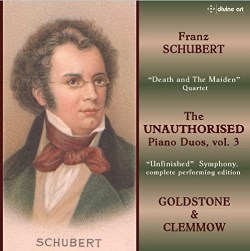
Support
us financially by purchasing this from |
 |
|
Franz SCHUBERT (1797-1828)
The Unauthorised Piano Duos - Volume 3
String Quartet in D minor. “Death and the Maiden”, D.810 (1824) (arr. Robert Franz, 1878) [38:28]
Symphony in B minor, Unfinished, D.759 and D. 797/1 (1822?) (complete performing edition, 2014) [35:27]
Anthony Goldstone (piano); Caroline Clemmow (piano)
rec. 2014, John the Baptist Church, Alkborough, North Lincolnshire
DIVINE ART DDA25125 [73:55]
Until very recently I have been repelled by arrangements and transcriptions. This applied to something like the ‘Rienzi’ Overture played on the concert organ through to the piano versions of Beethoven’s symphonies dished up by Franz Liszt. Ah well, age sometimes brings a more generous approach to matters that youth abhorred. There are three reasons why I have to a large extent changed my mind.
Firstly, for many generations a full symphony orchestra or even string quartet were not available without the cultural capitals of Europe. The only way that music-lovers would get to hear some works was by way of piano arrangements and transcriptions. It was a market that composers and publishers of the day catered to. I judge it is better to hear a masterpiece in an arrangement than not to have heard it all.
Secondly, I have come to be impressed by the ‘added value’ of some of these transcriptions. They can bring fresh life to what is often a hackneyed original. Schubert’s Unfinished was one of the very first symphonies that I heard, and I thought I knew it pretty well. Yet in the current piano duo version it is possible to hear nuances and details that have been submerged or blurred by repeated hearings.
This brings me to the third point. What can be found here are effectively ‘new’ works that have to be approached with renewed attention to detail. Clearly, the listener will recognize the progress of the work and the exposition and development of the themes. However, the new media can be so unfamiliar that it is like encountering a novelty. I think it is the ‘freshness’ of the present recordings of Schubert that have impressed me most of all.
The Death and the Maiden (Der Tod und das Mädchen) string quartet in D minor, No.14 was composed between 1824 and 1825. It was first performed on 29 January 1826. The title derives from the fact that the second movement of the quartet quotes part of the melody from Schubert’s eponymous song. Arguments have raged over the ‘programmatic’ nature or otherwise of this quartet. Is it supposed to be be meditation on ‘Fate and Death’? Other commentators have been impressed by the sheer skill that Schubert brought to the development of the musical material. It is ‘absolutely’ perfect and requires no underpinning ‘story’. The quartet has four movements: a gloomy ‘allegro’, followed by the more relaxed ‘andante con moto’ in the form of a theme with five variations. The scherzo has well-defined rhythms and the work concludes with a sonata-rondo movement of great power and speed. There is a direct quotation from the song ‘Erlkönig’ in the final pages.
The quartet was transcribed by the composer Robert Franz for four hands in 1878 as part of the commemorations to mark the fiftieth anniversary of the composer’s death.
The Unfinished is the popular title of what is Schubert’s Symphony No. 8 in B minor. Only the first two movements were completed, although sketches for the scherzo survive. In 1823 Schubert was made an honorary member of the Graz Musical Society. He composed the symphony for this society with a sense of obligation. The reason that Schubert did not complete it was most likely commercial. The composer needed money: this gift was unpaid.
The first two movements were presented to Anselm Hüttenbrenner, the Society’s president. The work was not heard in the composer’s lifetime although he survived for another five years after completion of these two movements. The score languished at Hüttenbrenner’s home until it was unearthed by Johann von Herbeck in 1865. It was duly performed in December of that year.
The work has been ‘completed’ on a number of occasions, including efforts by Felix Weingartner and Niels W. Gade.
The ‘complete performing edition’ of the Symphony in B minor, “Unfinished” presented here is derived from a number of sources. The opening two movements were transcribed for piano duet by Anselm Hüttenbrenner (1794-1868). The Scherzo and trio were completed and transcribed by the present pianist, Anthony Goldstone. The Entr’acte from the ballet music Rosamunde used for the finale was originally transcribed by Friedrich Hermann (1828-1907) and was adapted by Goldstone.
The liner-notes by Anthony Goldstone are indispensable reading for anyone who wishes to understand the background to these transcriptions.
I have not heard the first two volumes (dda 25026 and dda25039) of the ‘Unauthorised Piano Duos’ which include the ‘Trout’ Quintet, the ‘Rosamunde’ Overture, the ‘Arpeggione’ Sonata and the Trio in B flat. Based on the sheer delight that this present recording offers, they will be essential listening.
Anthony Goldstone and Caroline Clemmow (Goldstone and Clemmow) give a hugely attractive and competent rendition of these two popular works by Franz Schubert. However, it is the opportunity to hear these works in what to me is a new guise that makes this disc so rewarding. It banishes any residual aversion to transcriptions that I may still entertain.
John France
 |
 |
|
